In today’s rapidly evolving business landscape, organizations face the constant challenge of finding top-notch talent to meet their project-specific needs. While traditional hiring methods have their merits, more and more companies are turning to talent agencies as a strategic solution. These specialized agencies have emerged as game-changers in contract employment, offering various benefits that extend far beyond the surface. This article delves into the hidden advantages of partnering with a talent agency to hire contract employees and how it can propel your organization to new heights.
The Rise of Contract Employees:
The rise of the gig economy has significantly impacted the traditional employment landscape. More professionals seek flexibility, remote work opportunities, and diverse projects to expand their skills. Concurrently, businesses have recognized the benefits of engaging contract employees for their expertise without long-term commitment. As a result, hiring contract employees has become a strategic element of workforce planning.
The Talent Agency Advantage:
When seeking contract employees, organizations face the challenge of identifying the right talent from a vast pool of potential candidates. This process can be time-consuming and resource-draining. Enter talent agencies, the unheralded heroes of the talent acquisition realm. These agencies specialize in finding, vetting, and presenting highly qualified candidates for contract roles, streamlining the hiring process, and offering several key benefits:
1. Access to a Vast Pool of Talent:
One of the most significant advantages of engaging a talent agency is gaining access to a wide-ranging talent pool. These agencies have extensive networks and connections across various industries, allowing them to tap into a diverse pool of highly skilled professionals. Whether you require IT specialists, marketing experts, or manufacturing engineers, talent agencies can swiftly identify and match you with qualified candidates, saving you valuable time and effort.
2. Streamlined Recruitment Process:
Hiring contract employees can often be time-consuming and resource intensive. Talent agencies excel in streamlining the entire recruitment process. They possess the expertise to thoroughly screen and evaluate potential candidates, ensuring that only the most suitable individuals are presented to your organization. By leveraging their knowledge and experience, talent agencies streamline the hiring process, helping you quickly find the right person for the job.
3. Flexibility and Agility:
The ever-changing demands of business projects often necessitate a flexible workforce. Contract employees offer the agility required to adapt to these fluctuating needs. Talent agencies specialize in matching candidates with specific project requirements, enabling you to scale up or down your workforce as needed. This flexibility allows your organization to effectively manage costs, respond to market dynamics, and maximize efficiency.
4. Reduced Hiring Risks:
Hiring decisions can have inherent risks, particularly when selecting contract employees for short-term projects. Talent agencies help mitigate these risks by conducting comprehensive background checks, verifying qualifications, and assessing the candidate’s cultural add within your organization. By taking on the responsibility of pre-screening and vetting candidates, talent agencies help minimize the chances of a mismatch, reducing the risk of costly hiring mistakes.
5. Expertise in Industry Knowledge:
Talent agencies possess deep industry knowledge and insights, staying current with market trends and understanding the specific skill sets required for different projects. Their expertise allows them to provide valuable guidance and advice throughout the hiring process, ensuring that you find the most suitable talent for your unique needs. With their finger on the pulse of the industry, talent agencies are well-equipped to align your requirements with the rapidly evolving market landscape.
6. Increase Retention Rates:
Contract employees often bring a fresh perspective and specialized skills to the table. By leveraging the expertise of talent agencies, you can identify and attract highly motivated individuals who thrive in contract roles. These candidates often bring a wealth of experience and are driven to succeed, resulting in increased retention rates. Talent agencies help foster a positive working relationship between your organization and contract employees, enhancing job satisfaction and reducing turnover.
7. Customized Solutions:
Every business is unique, and talent agencies understand this. They tailor their services to suit the needs of individual companies, ensuring a seamless hiring process that aligns with organizational objectives.
8. Post-Hire Support:
Talent agencies do not just stop after finding the candidate. They often provide ongoing support to ensure the successful integration of the contract employee within the organization. At Swoon, we have a contractor care program that allows us to stay in contact with both the contractor and client to ensure continuous success and offer a wide range of benefits for our contractors.
Conclusion:
Partnering with a talent agency to hire contractors is a strategic move that offers a multitude of benefits for modern organizations. From gaining access to a vast pool of talent and streamlining the recruitment process to enjoying increased flexibility and reduced hiring risks, talent agencies empower businesses to achieve their goals efficiently. By tapping into the expertise and resources of these specialized agencies, you can optimize your workforce and unlock the potential for success in an ever-evolving business landscape. If you need help with hiring contract employees, let us know here.
In the ever-evolving recruitment landscape, 2024 marks a turning point as companies increasingly pivot away from conventional resume-centric hiring practices. The new focus is on a skills-based approach, signaling numerous advantages for both employers and job seekers. As your organization prepares for the next wave of talent acquisition, consider these actionable tips to integrate and excel seamlessly in skills-based hiring.
Clearly Identify the Skills You Need for Each Role
Gone are the days of generic job descriptions. The first step toward effective skills-based hiring is examining each open position. Scrutinize the hard and soft skills imperative for success, ensuring they align with the contemporary demands of the role. Precision is key; hone in on skills that are not only relevant but directly applicable to the position at hand. Utilize tools such as skill matrices to create a comprehensive overview of the skill landscape required, ensuring that your hiring strategy is finely tuned to your organization’s specific needs.
Use Structured Interviews to Assess Candidates’ Skills
A structured interview approach is pivotal in unraveling a candidate’s true capabilities. Craft questions that delve into their past experiences, prompting them to articulate how they have applied their skills in real-world scenarios. Incorporate behavioral questions to gauge problem-solving abilities and situational inquiries to assess adaptability. For a tangible gauge of hard skills, integrate skill tests or exercises into the interview process, offering actual evidence of their proficiency.
Emphasize Soft Skills
While hard skills are quantifiable, soft skills like communication, collaboration, and problem-solving should not be understated. Dive into candidates’ past experiences and use situational interview questions to uncover evidence of these critical attributes. Given the challenge of measuring soft skills, allow candidates the opportunity to demonstrate them during the interview process.
Require a Skills-Based Resume
Shift the paradigm by requesting applicants to submit a skills-based resume. This document should spotlight relevant skills, accompanied by evidence and examples showcasing proficiency in each area. Diminish the prominence of unrelated work experience and educational credentials that do not directly align with the sought-after skills.
Use Skill Rubrics and Templates for Structured Evaluations
Introduce structure into your evaluation process by employing skill rubrics and templates. A systematic scoring system for diverse skill sets can standardize your assessment of candidates, streamlining the interview and hiring processes across the board.
Cast a Wider Net for More Diversity
One of the standout advantages of skills-based hiring is its potential to diversify your talent pool. By removing biases tied to previous job titles or educational backgrounds, this approach opens doors to candidates from non-traditional sources who might otherwise be overlooked. Casting a wider net ensures that you tap into a rich pool of diverse, skilled individuals.
Conclusion
Adopting a skills-based hiring strategy is not merely a trend but a strategic imperative to align your workforce with organizational goals in 2024. Candidates possessing the requisite skills are poised to be more productive from day one, with more potential for future impact. Through planning and execution, skills-based hiring stands not just as a necessity but as a competitive advantage for companies in the year ahead.
In the dynamic world of modern recruitment, traditional strategies are giving way to innovative approaches that not only streamline the process but also ensure that top talent does not slip through the cracks. One such game-changing concept is proactive candidate engagement, a strategic initiative that is transforming the way organizations attract and retain the best-suited candidates for their teams. In this article, we delve into what proactive candidate engagement entails, the remarkable benefits it offers, why every forward-thinking hiring manager should care, and how staffing agencies are poised to play a pivotal role in its implementation.
What is Proactive Candidate Engagement?
Proactive candidate engagement is more than a buzzword; it is a fundamental shift in how recruiters interact with potential candidates. Unlike traditional reactive approaches, where recruiters wait for candidates to apply to job postings, proactive engagement involves actively identifying and building relationships with potential candidates before there is even a vacancy. This anticipatory method creates a talent pipeline, ensuring a steady influx of qualified individuals ready to step into roles as soon as they open up.
Benefits That Transcend Tradition
The benefits of proactive candidate engagement are far-reaching and impactful, driving tangible value for organizations aiming to secure a competitive edge in the talent market:
- Reduced Time to Fill: With a pre-qualified talent pool at their fingertips, hiring managers can significantly reduce the time it takes to fill critical positions. This agility is crucial in a fast-paced business landscape where every vacant role can affect productivity and performance.
- Enhanced Quality: Engaging with candidates before a position becomes available allows hiring managers to carefully assess skills, culture add, and long-term potential. This results in more tailored matches, translating into higher retention rates and improved team dynamics.
- Increased Diversity: Proactive engagement enables organizations to proactively address diversity and inclusion goals by building relationships with candidates from various backgrounds, ensuring a broader pool of qualified individuals.
- Strategic Workforce Planning: By cultivating relationships with passive candidates, hiring managers can better anticipate their organization’s future talent needs and strategize accordingly, aligning hiring initiatives with business objectives.
Why Should Every Hiring Manager Care?
In the fiercely competitive job market, the ability to secure top-tier talent can make or break an organization’s success. Proactive candidate engagement empowers hiring managers to take a proactive stance rather than relying on reactive measures that often result in settling for second-best. By tapping into a pipeline of pre-qualified candidates, hiring managers can ensure they are ahead of the curve, maintaining business continuity and minimizing the impact of turnover.
Ways To Take a Proactive Candidate Engagement Approach
Taking a proactive candidate engagement approach requires a shift in mindset and strategy. Here are several key steps and methods to implement proactive candidate engagement effectively:
- Talent Mapping and Pipelining: Start by identifying critical roles within your organization and creating a “talent map” of potential candidates for these positions. This involves researching and reaching out to individuals who have the skills and experience your organization needs, even before a specific role is open. Building a talent pipeline ensures a steady stream of qualified candidates when positions become available.
- Build a Strong Employer Brand: Cultivate a compelling employer brand that resonates with potential candidates. Showcase your company’s values, culture, and mission through various channels, including your website, social media, and employee testimonials. An appealing employer brand can attract passive candidates who are more likely to engage proactively.
- Leverage Social Media: Use social media platforms like LinkedIn or even Instagram or TikTok to engage with potential candidates. Share valuable industry insights, company updates, and thought leadership content. By establishing your organization as knowledgeable and forward-thinking, you will attract passive candidates who want to be part of your growth.
- Networking and Events: Attend industry conferences, workshops, and networking events to connect with potential candidates face-to-face. Hosting your own webinars or workshops can also position your organization as an industry leader and attract top talent interested in learning from your expertise.
- Employee Referral Programs: Encourage your existing employees to refer potential candidates from their networks. Employees often have connections with individuals who share similar values and skills, making them excellent sources for passive candidate recommendations.
- Engaging Content Creation: Develop content that resonates with potential candidates. This could include blog posts, videos, podcasts, or even e-books that provide insights into industry trends, career advice, and skill development. This not only establishes your organization as a thought leader but also keeps candidates engaged over time.
- Personalized Outreach: Reach out to potential candidates with personalized messages that highlight how their skills and experience align with your organization’s needs. Show genuine interest in their career aspirations and goals, demonstrating that you value their potential contributions.
- Talent Communities and Newsletters: Create talent communities or newsletters that provide valuable content and insights to potential candidates. This allows you to maintain a connection with candidates even when there are no immediate job openings.
- Regular Check-ins: Keep in touch with passive candidates periodically, even if there are no immediate opportunities. Share updates about your organization, industry trends, or other relevant news. This maintains the relationship and ensures that candidates remain engaged.
- Utilize Technology: Leverage applicant tracking systems (ATS) and customer relationship management (CRM) tools to manage and nurture candidate relationships. These systems can help you track interactions, set reminders for follow-ups, and ensure that candidates are engaged effectively.
- Data-Driven Insights: Use data analytics to identify trends, preferences, and behaviors of potential candidates. This can help you tailor your engagement strategies to resonate with their interests and motivations.
- Continuous Learning Opportunities: Offer webinars, workshops, or courses that provide valuable learning experiences for potential candidates. By investing in their professional development, you demonstrate your commitment to their growth, making your organization an appealing destination for their careers.
Staffing Agencies: The Architects of Success
While the concept of proactive candidate engagement is alluring, its execution requires a strategic approach and considerable resources. This is where staffing agencies come into play as invaluable partners for your organization seeking to harness its benefits. Staffing agencies possess the expertise and infrastructure to identify, engage, and nurture potential candidates, while aligning their skills and aspirations with the needs of client organizations.
By leveraging their extensive networks, advanced technologies, and industry insights, staffing agencies can help organizations build and manage talent pipelines that not only fulfill immediate needs but also anticipate future demands. This collaborative approach not only saves time and resources for hiring managers but also ensures a steady stream of quality candidates who are already aligned with your organization’s values and goals.
Conclusion
Proactive candidate engagement is more than a strategy – it is a paradigm shift that is redefining the recruitment landscape. The benefits are evident, from shortened hiring cycles to elevated quality and improved workforce planning. For hiring managers with a vision for success, adopting this approach is non-negotiable. Fortunately, with staffing agencies ready to step in as partners, the journey toward a proactive and powerful talent acquisition strategy is well within reach. As businesses continue to adapt to the evolving nature of work, those who embrace proactive candidate engagement will undoubtedly lead the charge toward a brighter, more talent-rich future.
In today’s fiercely competitive job market, attracting top talent is a constant challenge for companies across all industries. While a compelling job description and competitive salary are essential, employer branding is an often overlooked yet powerful tool in the talent acquisition arsenal. A strong employer brand not only enhances the candidate experience but also acts as a magnet, drawing in the best candidates to your organization. In this article, we explore how companies can harness the power of employer branding to elevate the candidate experience and win over top talent.
1. Define and Showcase Your Unique Culture
At the core of a strong employer brand lies a distinct company culture. Companies must clearly define their values, mission, and vision, showcasing what distinguishes them from competitors. Whether it’s a commitment to innovation, a supportive work environment, or a focus on work-life balance, communicating these unique aspects authentically attracts candidates who align with the organization’s values.
2. Tell Authentic Employee Stories
Authenticity is the bedrock of an effective employer brand. Share real employee stories and testimonials instead of relying solely on marketing jargon. Potential candidates want to hear about your current employees’ experiences, their company growth, and how your organization has supported their professional development. This transparency builds trust and gives candidates a glimpse into what being part of your team is like.
3. Engage on Social Media and Company Platforms
Social media has transformed how candidates perceive and interact with companies. Engaging on platforms like LinkedIn, Twitter, and Instagram provides a window into your organization’s culture and values. Companies can use these platforms to share company updates, showcase employee achievements, and highlight community involvement. Consistent and engaging content fosters a positive impression and keeps top talent interested in your brand.
4. Prioritize the Candidate Experience
The candidate experience starts from the first touchpoint with your company: the application process or the interview stage. Ensuring a smooth, respectful, and timely experience for candidates is paramount. Personalized communication, prompt feedback, and transparency throughout the hiring process are key elements that create a positive lasting impression on candidates, regardless of the outcome.
5. Leverage Employee Advocacy
Your current employees can be powerful brand advocates. Encourage them to share their positive experiences on social media and professional networks. Employee-generated content can significantly influence how potential candidates perceive your organization. Establishing an employee referral program can also be an effective way to attract top talent, as candidates are more likely to trust and consider recommendations from current employees.
6. Showcase Professional Development Opportunities
Top talent seeks opportunities for growth and career advancement. Highlight your company’s commitment to employee development, such as training programs, mentorship initiatives, and support for continuing education. Demonstrating a clear path for growth within your organization makes it an attractive prospect for ambitious candidates.
7. Invest in Diversity and Inclusion
Diversity and inclusion have become critical factors in attracting top talent. Companies with diverse and inclusive cultures tend to outperform their peers. Showcase your commitment to diversity through initiatives, partnerships, and employee resource groups. Demonstrating an inclusive environment signals that your organization values and respects individuals from all backgrounds.
Conclusion
Employer branding is a powerful tool for attracting top talent and elevating the candidate experience. By defining and showcasing your unique culture, telling authentic employee stories, engaging on social media, prioritizing the candidate experience, leveraging employee advocacy, promoting professional development opportunities, and investing in diversity and inclusion, your organization can create a compelling employer brand that resonates with the best candidates. A strong employer brand not only attracts top talent but also fosters a sense of pride and loyalty among current employees, creating a thriving and successful workforce for the future.
Organizations are constantly seeking ways to enhance productivity and maximize their output. Increased productivity not only leads to improved efficiency and profitability but also fosters a positive work culture and employee satisfaction. However, achieving higher levels of productivity requires a strategic approach that encompasses various factors, including employee engagement, effective management, and a conducive work environment. In this article, we will explore practical strategies that organizations can implement to increase profitability in the workplace.
1. Encourage Goal Setting and Prioritization
Setting clear, achievable goals is vital to drive productivity. Encourage employees to establish both short-term and long-term goals that align with the organizational objectives. Help them prioritize tasks and focus on high-value activities by providing guidance on time management techniques, such as using productivity tools and creating to-do lists.
2. Cultivate a Culture of Purpose
A sense of purpose is a powerful motivator for employees. Clearly communicate the organization’s mission, vision, and values, ensuring alignment with employees’ personal goals and aspirations. Encourage team members to understand how their work contributes to the larger picture, fostering a collective sense of purpose and driving intrinsic motivation.
3. Invest in Employee Development
Providing opportunities for growth and development not only enhances employees’ skills but also boosts their motivation and engagement. Offer training programs, workshops, and mentorship opportunities to help employees expand their knowledge and acquire new competencies. This investment in their professional growth will pay dividends in terms of increased productivity and loyalty.
4. Streamline Work Processes
Inefficient workflows can hinder productivity. Analyze existing processes and identify bottlenecks or areas of improvement. Streamline workflows by leveraging technology, automation, and product management tools. Encourage cross-functional collaboration and ensure that roles and responsibilities are clearly defined, minimizing duplication of efforts and increasing efficiency.
5. Promote Work-Life Balance
A healthy work-life balance is crucial for maintaining high levels of productivity and preventing burnout. Encourage employees to take regular breaks, practice self-care, and disconnect from work during non-working hours. Offer flexible work arrangements, when feasible, to help employees manage personal commitments effectively. A balanced lifestyle results in more focused and energized employees.
6. Foster Effective Communication
Clear and effective communication is the cornerstone of a productive workforce. Encourage open dialogue, active listening, and transparency. Ensure that employees have access to the information they need to perform their tasks efficiently. Utilize collaboration tools, hold regular team meetings, and establish channels for feedback to foster effective communication across all levels of the organization.
7. Recognize and Reward Achievements
Recognition and rewards are powerful motivators that can significantly impact productivity. Acknowledge and appreciate employees’ accomplishments and efforts publicly. Implement reward programs that align with individual and team goals. Consider offering incentives, such as bonuses, additional time off, or opportunities for advancement, to recognize exceptional performance.
8. Promote Health and Wellness
Physical and mental well-being directly influence productivity. Encourage a healthy lifestyle by providing wellness programs, ergonomic workstations, and access to fitness facilities. Offer resources for stress management, mental health support, and work-life balance workshops. Prioritizing employee well-being contributes to a more energized and focused workforce.
Conclusion
Maximizing workplace productivity requires a holistic approach that considers various factors, including culture, technology, employee well-being, communication, and process optimization. By cultivating a purpose-driven environment, embracing technology and automation, prioritizing employee well-being, promoting continuous learning, enhancing communication and collaboration, optimizing workflows, and recognizing excellence, organizations can unlock the full potential of their workforce and drive sustainable success. Embrace these strategies and empower your team to reach new heights of productivity, efficiency, and innovation, setting your organization apart in today’s competitive business landscape.
Retaining your top talent has always been a challenge for organizations. In 2023, as the job market becomes increasingly competitive and employees have more opportunities, it becomes even more crucial for companies to implement strategies to keep their best employees. Losing top talent can be a significant setback for any organization, both in terms of financial costs and the loss of institutional knowledge and expertise. In this article, we will discuss the top 5 strategies for retaining your top talent in 2023.
Offer competitive compensation and benefits
Offering competitive compensation and benefits is essential for retaining top talent. Companies need to ensure that their compensation packages are competitive and meet market standards. Besides, companies need to provide a comprehensive benefits package that includes health insurance, retirement plans, paid time off, and other perks.
Companies can conduct regular salary surveys to provide competitive compensation and benefits to ensure that they offer fair compensation. Additionally, they can offer flexible benefits packages that allow employees to choose the benefits that suit their needs.
Provide opportunities for growth and development
Employees want to work for a company that values their skills and provides opportunities for career growth. Companies that invest in their employees’ professional development are more likely to retain top talent. Employees who see a clear path for advancement within their organization are more likely to stay and contribute to the company’s growth.
To provide opportunities for career growth, companies can offer training and development programs, mentorship, job shadowing, or cross-functional projects. As a result, employees who feel they are growing professionally and are given opportunities to develop new skills and expertise are more likely to stay with the company.
Create a positive work culture
Positive work culture is crucial for retaining top talent in 2023. Employees want to work in an environment where they feel appreciated and valued. Companies can foster a positive work culture by promoting open communication, collaboration, and teamwork.
To create a positive work culture, companies can organize team-building activities, establish mentorship programs, and provide opportunities for socializing and networking. A positive work culture not only increases employee retention but also enhances employee productivity and job satisfaction.
Provide work-life balance
Work-life balance is a priority for many employees. Companies offering flexible work arrangements, such as remote work or flexible schedules, are more likely to retain top talent. Providing work-life balance can also increase productivity, job satisfaction, and employee well-being.
To provide work-life balance, companies can offer flexible work arrangements, such as remote work, part-time work, or job sharing. They can also offer paid time off, including parental, sick, and vacation days.
Recognize and reward employees
Recognizing and rewarding employees for their performance is critical for retaining top talent. Employees want to know that their hard work and contributions are appreciated and recognized. Therefore, companies that recognize and reward their employees’ performance are more likely to retain them.
To recognize and reward employee performance, companies can offer performance-based bonuses, promotions, or awards. They can also offer non-monetary rewards, such as additional time off, work-from-home days, or the opportunity to work on a special project.
Retaining top employees requires a multi-faceted approach. Companies need to offer competitive compensation and benefits, provide opportunities for growth and development, create a positive work culture, provide work-life balance, and recognize and reward employees. By implementing these strategies, companies can work to retain their top talent and have a competitive edge in the job market.
Written in conjunction with Joe Matalone – Executive Vice President, Chris Thrall – Director of Talent Solutions and Colin Harris – Business Development Lead.
With many companies starting to kick up their hiring initiatives again, they need to figure out the best hiring process for their company.
Since COVID-19 left many furloughed, the talent pool has grown substantially. Something that we haven’t seen in years. Below, we will discuss direct hire, contract-to-hire and temporary processes and the best situations in which to use them.
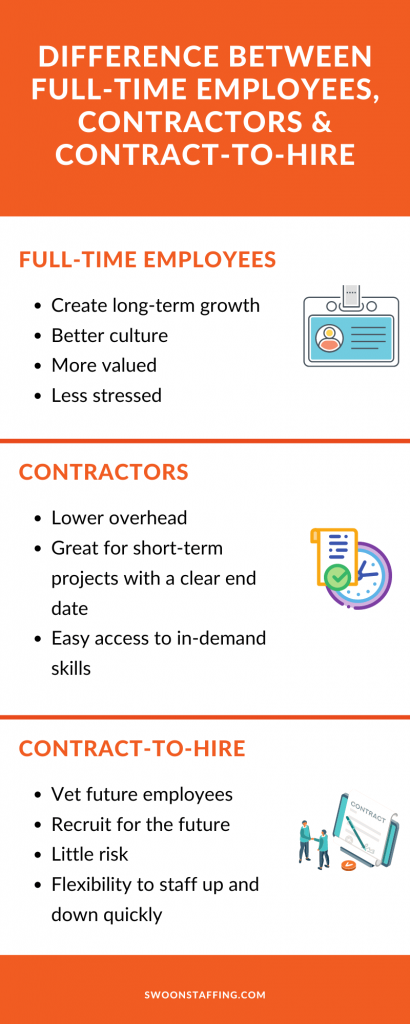
Recap of Definitions
Direct Hire Placement: A staffing agency adds permanent staff directly to another company’s payroll.
Temp Staffing: A candidate is hired as a solution for unpredictable workloads, project work, seasonal peaks and other short-term needs such as a leave of absence. They are employed by the staffing agency and all positions have an established timeframe.
Contract-to-Hire: The selected candidate begins their employment contract on the staffing agency’s payroll, not the client’s. They are placed in a short-term position for a set period, with the possibility of being hired as a full-time employee at the end of that contract.
Advantages
Direct Hire:
- The candidate is sourced as a full-time employee from day one. This allows you to avoid the annuity costs associated with contract/contract-to-hire employees and your new hires feel that they are part of the team right away.
- Direct hire roles are more attractive to passive candidates. Thus, allowing you to see a higher number of highly qualified candidates.
- This is evident because you can offer better perks and benefits packages to attract the type of prospective candidates you are looking for.
- Typically, there is stronger employee commitment. These employees often have a better sense of stability and security within the company that they are placed in.
Contract/Temp Employees:
- Saves your company time and money. These employees allow you to get the help that your company needs quickly without the cost and effort of recruiting and hiring full-time staff members.
- Offers flexibility by helping companies fill openings quickly that are caused by seasonal demand or employee absence. This way, companies can meet demands while not overstaffing or requiring current team members to take on more tasks.
- You can tap into skills that you currently don’t have inhouse. This way, you can quickly complete projects that your current team members don’t have the skills or experience.
Contract-to-Hire:
- The ability to experience a trial run. You can “try before you buy” and minimize the risk of an employee not being a fit long-term.
- There is more budget flexibility.
- These positions can give a company the time to work a new full-time employee into the budget while still getting the work done.
- Contract-to-hire employees are typically not eligible for benefits until they become a full-time employee. However, in most cases, they get the option of receiving benefits through the staffing agency they are working with.
- The employees are typically only paid on an hourly basis for the specific hours worked rather than a fixed salary.
- You can save on specialized skills that you don’t already have in-house. Contractors can help you complete projects that require skills and experience that your full-time staff doesn’t already have.
- Contract-to-hire can help you accommodate growth. We can’t always predict when growth or expansion needs to happen, and this can be extremely difficult for your full-time employees to take on additional work themselves when they have a full workload already. During these times, you can leverage contract staffing to complete the necessary extra work.
How Does Contract-to-Hire Work?
When you use a staffing agency to fill contract-to-hire positions, they will handle many of the front-end recruiting tasks, such as:
- Sourcing candidates
- Reviewing resumes
- Conducting initial screenings
Once a candidate has moved through these stages, they will be passed along to the client for final interviews. The company will then make the final decision with insights and guidance from the staffing agency if needed. Once a candidate is selected and accepts an offer, they will begin their employment contract on the staffing agency’s payroll rather than the client’s.
The duration of these contract-to-hire positions varies from one month to being indefinite. However, they will usually run from three to twelve months. In most situations, the client will have the opportunity to convert the contractor to a full-time hire in a manner that meets their needs.
Why Would a Company Dismiss the Idea of Hiring a Contractor?
When it comes to a company dismissing the idea of hiring a contractor, a few things come to mind.
- Contractors can be more expensive than hiring a full-time employee, depending on the situation.
- It’s more cost-effective to pay for a full-time employee than a contractor if you are going to keep them on for 2-3 years in some cases.
- Operating expenses (OPEX) are the cost of doing business, such as employee wages, utilities, insurance, and rent required for the day-to-day functioning of a company (including employee wages). In contrast, a capital expense (CAPEX) is an expense that a business incurs to create a benefit in the future (such as an IT project to upgrade a system that could require contractors to come in and complete that project). OPEX and CAPEX are treated quite differently for accounting and tax purposes and could be the reason for hiring one over the other.
- Companies don’t want to lose intellectual property. However, as a company hiring a contractor, you can have a written agreement executed before the commencement of the employment relationship. This agreement can assign to the company any and all intellectual property created by the employee during their employment with the company.
- Companies don’t have a history of hiring contractors and are unaware of the process – this is where we can come into play and help you understand the best path for your needs.
- Companies have budgetary challenges and might not be able to afford the contractor fees on top of the full-time employee fees if they choose to hire after the contract is up.
- Employees miss out on getting proper integration into the company culture.
- A company is challenged to bring in revenue, thus putting projects on hold that they could bring in a contract-to-hire to complete.
Why is Direct Hire Skyrocketing During COVID-19 and Not Contract-to-Hire?
At the beginning of this recession, we thought that we would see an increase in contract-to-hire over direct hire placements. When asked, Joe Matalone – EVP, had a great response to why he believes that direct hire placements are skyrocketing now.
“I think we can find our answers here in analyzing the U.S. stock market and employment data at the beginning, middle and present times of COVID-19.
Beginning of COVID-19: What we saw in the very early days of COVID was simply confusion at all levels as it came at us so quickly – which frankly jolted the global markets. Millions were furloughed during the pandemic, with a record 20.5 million U.S. jobs lost in April. However, some companies were and still are hiring thousands of new employees to keep up with shifting consumer demands and spending habits. That being said, some employers may have cut too deeply (particularly in the departments of Talent Acquisition) and have now realized that they need to hire again and hire quickly to maintain any competitive edge. Suddenly, there is a fresh wave of talent that the employers have not seen in many years due to the historical run of strong overall employment numbers.
Present Day: Fast forward to the present; it feels like the market is tightening again in specific skillsets, most notably in digital and technology, which were more resilient to the downturn. It’s almost as if we’re not in a recession any longer.
Final Thoughts: I think this will be the fastest end to a recession ever! Some areas of the market will take longer to recover, such as travel/retail/hospitality. Some employees that had been placed on leave, laid off, or maybe not treated so nicely during the last few months are looking and have options. You add in the embracement and acceleration of hiring remote workers now, and the talent pool gets very large.
During economic downturns, candidates are unwilling to leave their current “permanent” position for anything but a direct-hire position. When the country is in the middle (or hopefully tail end) of a pandemic, benefits such as health insurance are top-of-mind for everyone.”
Joe Matalone – EVP at Swoon
Conclusion
It’s important that you take a look at what is best for your company at that time. What works for one company might not necessarily work for yours. Will your company benefit more from having a direct-hire placement for a full-time employee, a temporary contractor or a contract-to-hire so that you may “try before you buy”? There is no right or wrong answer. It all just comes down to what you think will be the best, and if you have any questions along the way, we are always here to help!
As the pandemic has shifted work trends, businesses must continue to be agile, set employees up for success, establish safety measures and discover the new normal. We wanted to share a few ways we are adapting within our company as well as provide some insight into how work trends are evolving.

According to Gartner analysis, 48% of employees will work at least part of the time in a remote environment after being allowed back into our offices. But how will this look? It will all depend on your company and the work environment that you want your employees to have. However, encouraging employees to work from home, at least part of the time, will help stop the spread of COVID-19 around the office, and it will also help prepare your company if a similar situation arises.
At Swoon, we’re offering a work from home extension option for the remainder of 2020. Offering this extension allows our employees to make a conscious decision about what would work best for them and their families—keeping safety and comfortability a top priority.

Employers played an expanded role in an employee’s mental well-being throughout the time of social distancing and working from home. This has ultimately changed the way employers view the employee experience. You may have started to focus on increasing your employees’ social engagement and morale, which in turn helped increase productivity and reduce burnout. This is something that most companies should continue to implement, even with offices being open.
At Swoon, to improve moral, we implemented Innovation Kitchens (IK Breaks) and will continue them for the foreseeable future. They have been a great way to increase morale, involve the entire team and make sure employees take breaks throughout the day. Some examples of what we’ve done in the past include:
- Workout – A 30-minute workout to get us all motivated and finish our day out strong.
- Yoga – A Slow-Flow Yoga class hosted by an old pal of Swoon, a certified yoga and meditation teacher.
- Dance Party – A DJ set put on for our team to socialize and have some fun.
- Full-Body Strength – A 30-minute full-body strength workout led by one of our respected Armed Services members who also happens to be the sister of one of our Swooners! Click here to see her page.
- Flower Arranging – A how-to on arranging a simple bouquet that you can pick up at your local grocery store.
- Tiger King Trivia – Most of us binged the whole thing, so of course, we had to have a friendly competition around it.
- Foreign Language Class – A class around learning a few pleasantry words in Russian, Spanish and Polish.

Now, more than ever, transparency has been a huge factor in employee morale and happiness. Being transparent in company decisions leaves out any question about what will happen in the next few months. It allows your employees to prepare and feel supported during these unknown times.

This will be true for larger cities where most people use public transportation. It’s doubtful that we’ll see crowded buses, trains and metro stations during peak hours anytime soon. Why will it be this way?
- Many people will be wary of using public transportation unless it’s necessary.
- Organizations will start to stagger their shifts.
- Many employees will still work from home at least part of the time.
- Public transportation will have limits and regulations to follow.
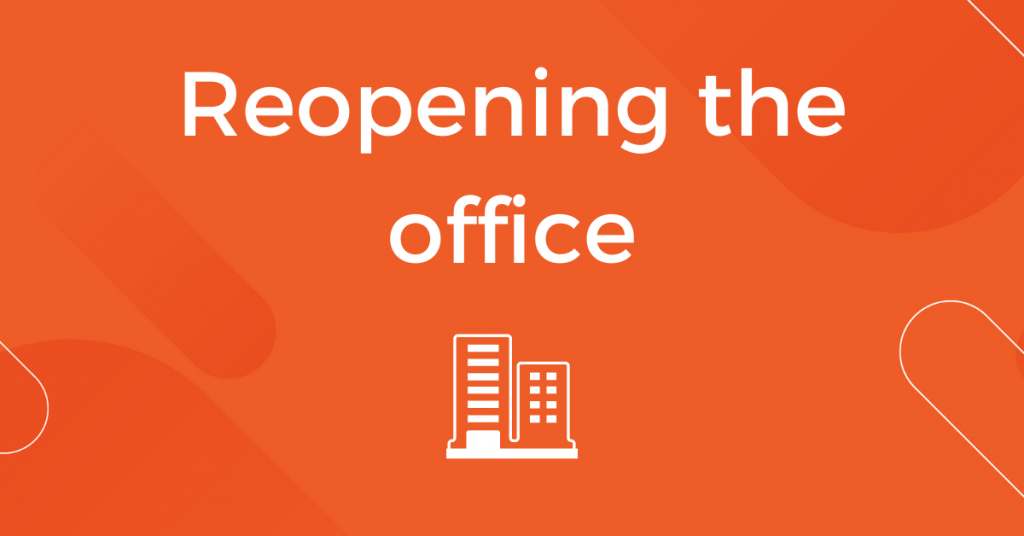
Of course, most of us are longing for some face-to-face conversations with our coworkers! We miss the times of being in the office and being able to have connections with those around us. How can we get our employees the time with their coworkers while still being safe? Well, workplaces will need to impose new elements into the office. You’ll need to figure out how to protect your employees and mitigate an outbreak from happening. The office of the future may look very different and might include:
- Getting rid of open floor plans
- Adding plexiglass sheets around desks
- Reconfiguring desks to be 6 feet apart
- Shifts for communal spaces such as bathrooms and break rooms
- Dedicated office entrances and exits
- Temperature checks at entrances
- Removal of common seating areas
- Staggering shifts
- Rotating work from home days and in-office days, so fewer employees are in the office at one time
- Having employees wear PPE
- Increasing sanitation measures
- Increasing video meetings and reducing in-person meetings
In addition to offering the work from home extension at Swoon, we’re also allowing the ability for employees to come into the office if they wish to do so. So, what steps is Swoon taking?
- Getting rid of the open floor plan and creating desk spaces
- Increasing sanitation efforts and requiring PPE to be worn
- Having all employees clean out their desks to ensure they can be deep cleaned at the end of each day
- Having flexible start and end times to make it easier on those who use public transportation

This is the time to go back to the drawing board and say, “what works for our organization and what doesn’t” and utilize those points to make changes as you see fit. It’s also going to be more critical now that as a leadership member, you’re as transparent as possible. Let your employees know what is going on and what steps are being taken. This way, the next few months go as smoothly as possible.
Companies are still hiring but are now faced with a new challenge – onboarding new hires remotely. As employers, it’s important to set the groundwork for bonding, culture and expectations in order to be successful. Being that many of our clients are facing similar challenges, we wanted to share a few best practices that will set you new team members up for success.
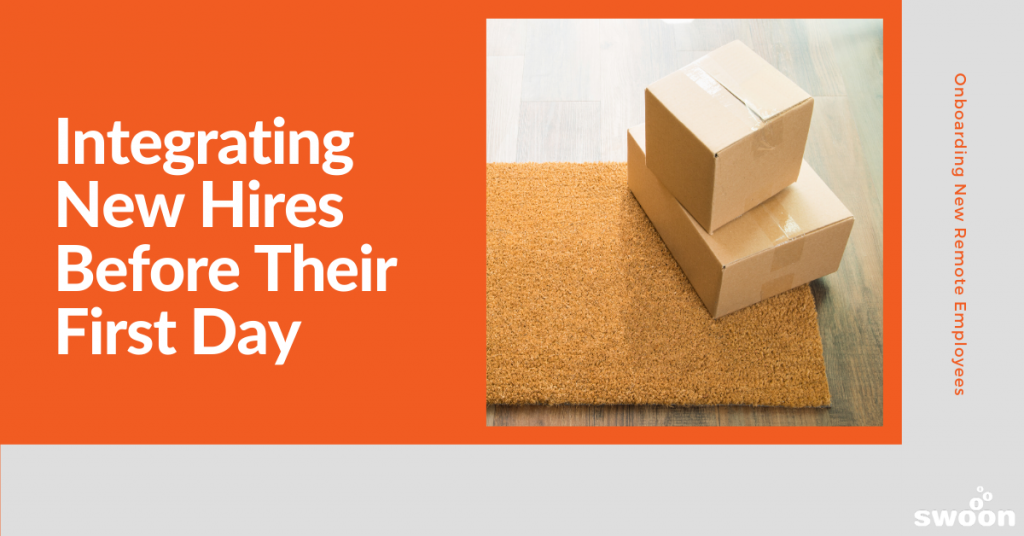
Integrating New Hires
Starting your onboarding process before their start date ensures that your new hire will have everything that they need to hit the ground running. Some suggestions on items to send before their first day include:
- Welcome email and team introduction
- HR/company documents
- All proper equipment/technology
- The information they should know before their first day
- Their onboarding schedule—this way they can be prepared for what their first week will entail
- Company swag to feel a part of the team and get excited for their new role

Tech Should Be First Priority
Let’s take a minute and put ourselves in the position of the new hire. Starting a new job can be stressful enough without adding in the issue of not knowing how the various software platforms and communication channels work. We find that sending new hires their equipment and online tutorials/manuals before their first day helps them to feel prepared and eases any unnecessary stress. You’ll want to make sure that you have a follow up IT training scheduled for the first or second day. That way, any questions that your new hires have after watching the tutorials or reading the manual can be answered right away.
Things to cover during your IT training could include:
- Company email
- Group messaging tool
- Video communication software
- File-sharing applications (Google Drive, Dropbox, Microsoft OneDrive, etc.)
- Computer and email security applications

Demonstrating Culture
We know this can be a challenging thing to do through an online platform. But, taking the time to show your company’s culture can really add value to the new hire’s first week. Through video calls, you can accurately demonstrate your company’s culture while offering a way for everyone to feel included in their first week. It also allows you to introduce them to higher-level executives, either through a video conference call or a prerecorded video. Some video topic ideas to show your company culture can include:
- Welcome video or video call from your CEO or President and other team members
- Your culture, organizational values and mission, the history of the organization, etc.
- Inspirational messages from a member of your leadership team
- Retreat, event, volunteering, etc. footage from before everyone was social distancing

Setting Expectations
When working remotely and bringing on new employees, managers should be prepared to set specific goals and expectations early on. You don’t want them to have to wait for their manager or team lead to get online to learn what their next tasks are for that day. This wastes time and may cause unnecessary stress. You’ll want to make sure that your hiring managers:
- Develop and share a task calendar with their new hires after their training and onboarding sessions are complete
- Define short-term and long-term goals
- Schedule weekly one-on-one meetings to discuss upcoming projects, progress, resolve any issues they are facing, and overall just check in with how things are going
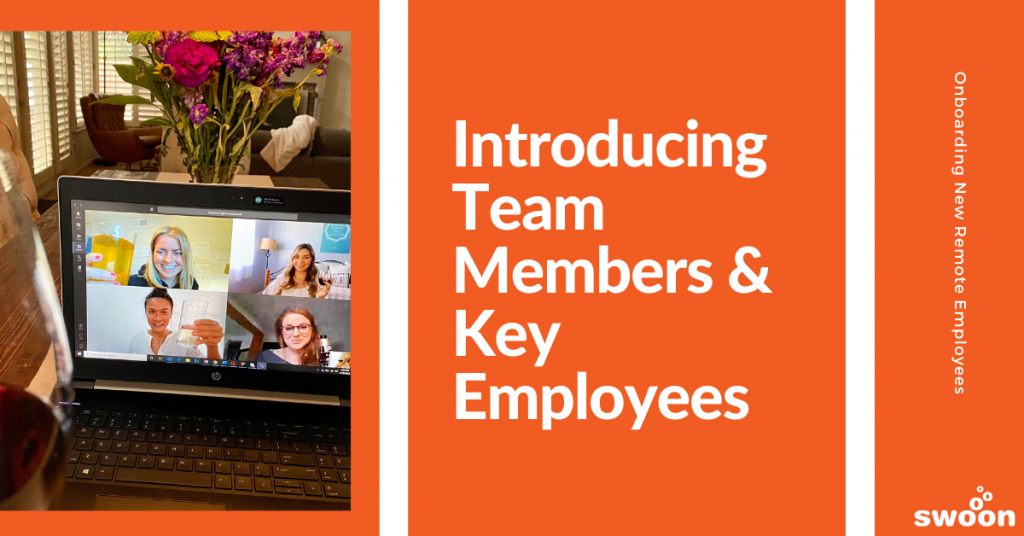
Introducing Team Members and Key Employees
We all know that starting a remote role can leave some feeling isolated and even left out from the team. They haven’t had the chance to connect with the team and doing so online can prove to be very challenging. But, building relationships is well worth the effort! Set up one-on-one meetings and/or a group call so employees can meet the people they will be working with. Not only does this open a path for communication, but it also allows them to feel included within their team. Try having the manager set up bi-weekly team meetings, virtual happy hours or an open chat channel to give everyone on their team time to talk with their new coworker.

Arrange Trainings
Now we know that this is probably self-explanatory, but make sure you set aside time for the new hires to sit down with a hiring manager or a team member to train them on their role. This can be very similar to how you train in the office; however, you will need to adapt to be virtual. Screen sharing is a great way to keep things simple. We find that this is the easiest way to adapt, and it allows the new hire to ask questions in real-time, something that might be more difficult if you were to only do a prerecorded training.

Improving Your Process
Continue to improve your onboarding process to find what bests works for your team and your culture. Ask for feedback and don’t be afraid to be creative in tackling these new challenges. We predict remote hiring will become even more common, so this is a great time to build onto an ongoing process.
Need some more help with your remote onboarding process? We would love to talk you through what has worked for us in the past and answer any questions that you have!
Grab your drink of choice, cuddle up next to your pet and get ready for your next happy hour!
Right now, since everyone is in sort of a long-distance relationship, virtual happy hours are more important than ever to keep up with social interaction, have some laughs and figure out different ways to connect with each other.
There are many ways that we’ve found to keep our employees engaged and feel involved while working remote and we want to share those with you!
Have Fun!
One way that we’ve found to keep these virtual happy hours fun and really learn more about each other is to incorporate remote team building! Not only does this allow your employees to know each other, but they are also a great stress-reliever.
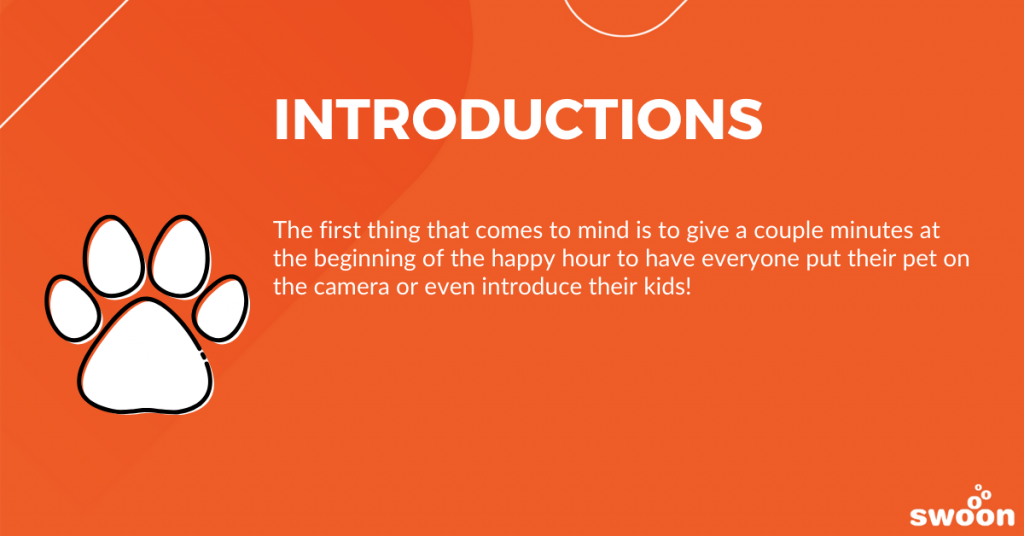
Introducing Pets/Kids!
Coworkers hear stories about everyone’s kids or pets either when they were in the office or over chat. Give them the opportunity to meet them on camera.
Play Some Icebreaker Games
Okay, we know what you’re thinking, “…but these are so cheesy!” Yes, we know they’re cheesy, but they’re also amazing at allowing your employees to talk and get to know each other better. Being remote can get extremely lonely and you want to offer time for employees to unwind. Here are some of our favorites!

1. What’s Your Favorite Thing?
This is a great game to play when you aren’t sure how people will respond to playing an icebreaker game during a happy hour.
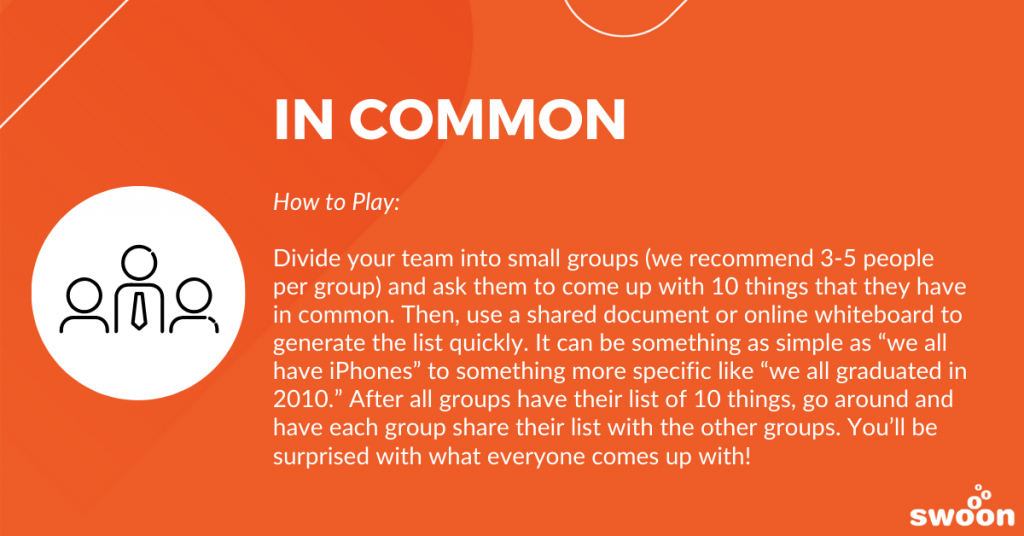
2. In Common
Is your team having trouble coming up with new ideas or communicating effectively while being remote? This could be your solution! This game allows your employees to get back on track and work as a team to achieve the end goal in a non-stressful environment!
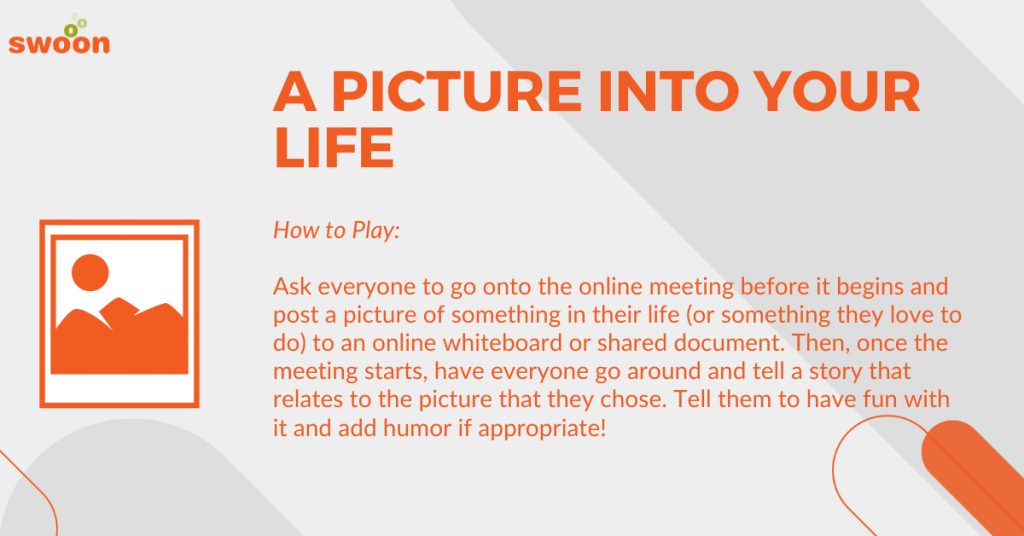
3. A Picture into Your Life
This game will allow your team to have fun and put their creativity to the test!
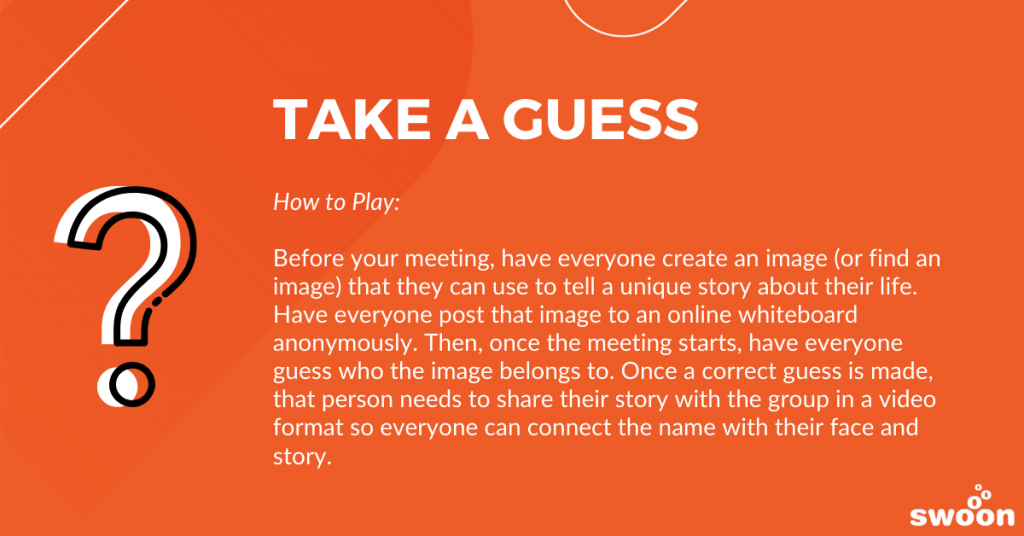
4. Take A Guess
Here is another game that allows your employees to utilize their creativity skills and learn about their coworkers in a fun way!
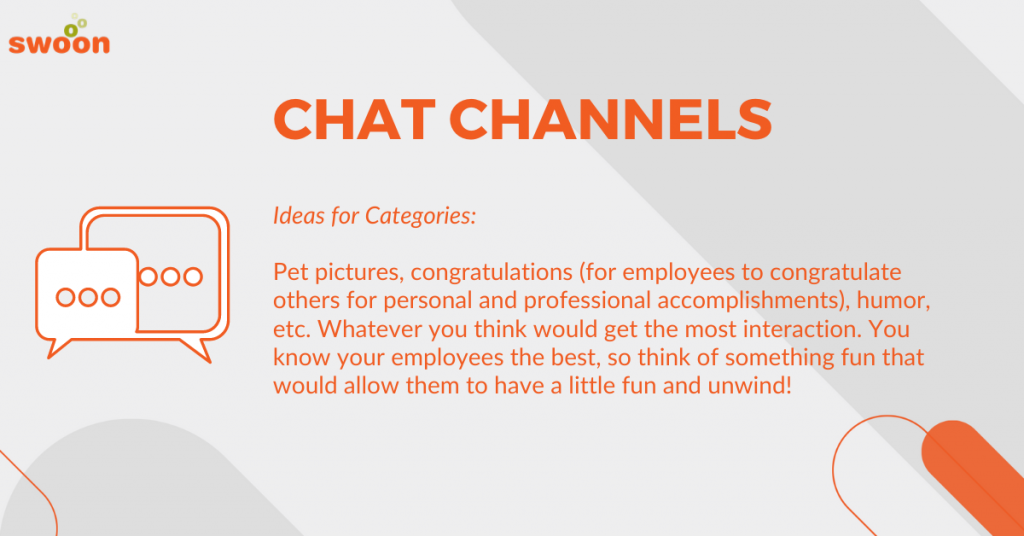
5. Chat Channels
Create fun, dedicated chat channels and announce them during your virtual happy hour. Do you know that your employees won’t respond well to a team building exercise? This could be the way that you get your employees to connect in a remote environment!

Keep It Simple!
You don’t need to always do something outside the box. Sometimes, the best way to get your employees to feel included is to just set up a time and space for them to talk and see one another. Having them add in their drink of choice allows the environment to feel a little more comfortable and laid back.
Need Help?
We would love to help you and your team navigate this new work from home environment! No matter if that’s through finding the best virtual happy hour solution or just the best work from home solution for you and your team. We’ve been doing this for a little over a year, so we would love to provide you with our insight! Feel free to send us a message!

